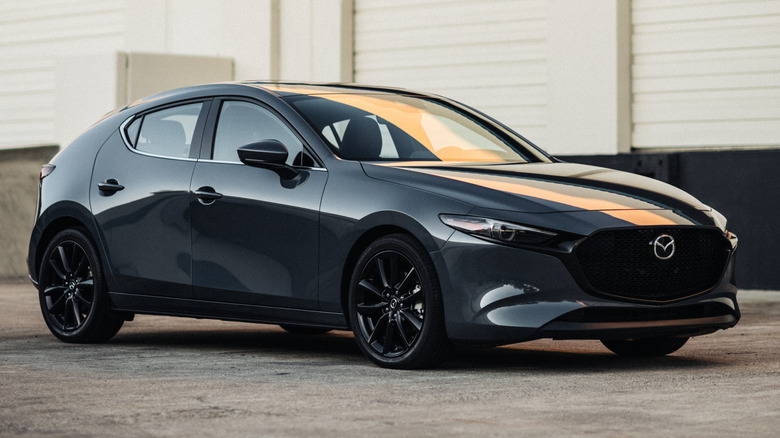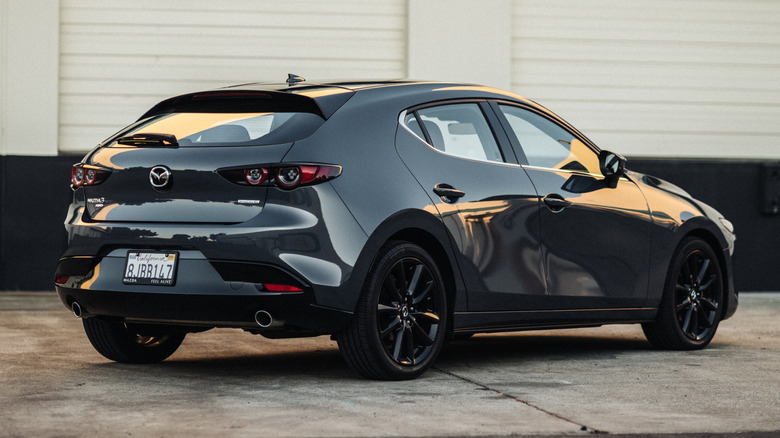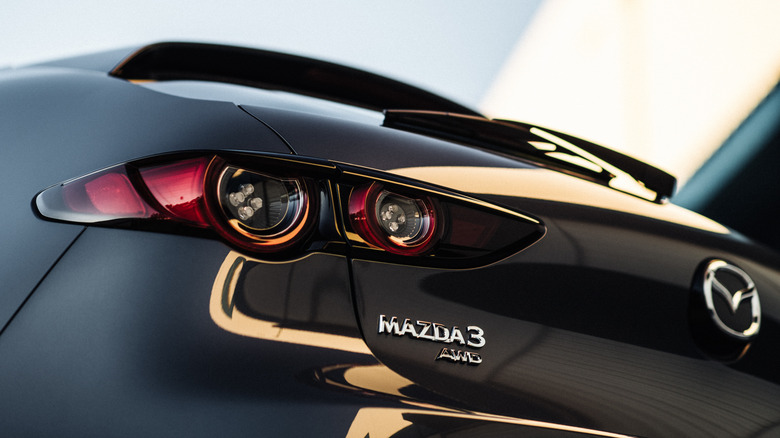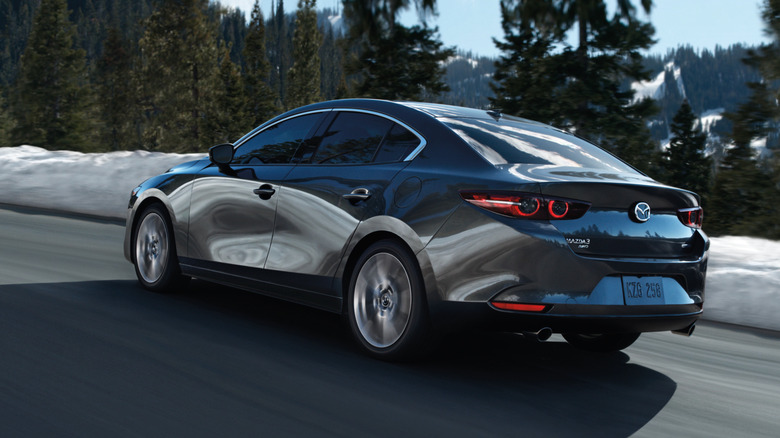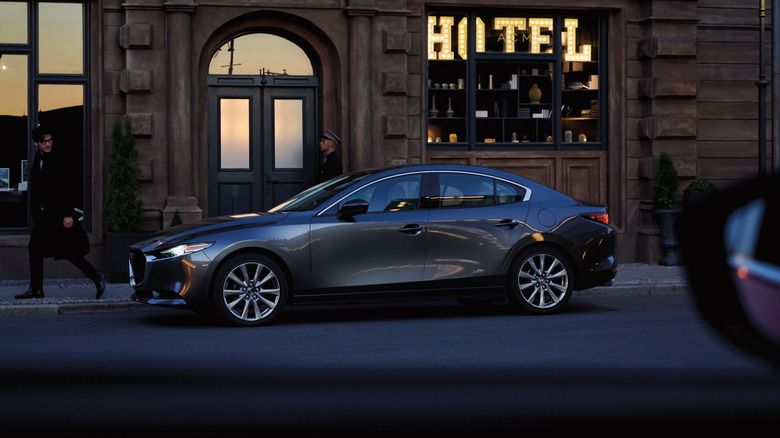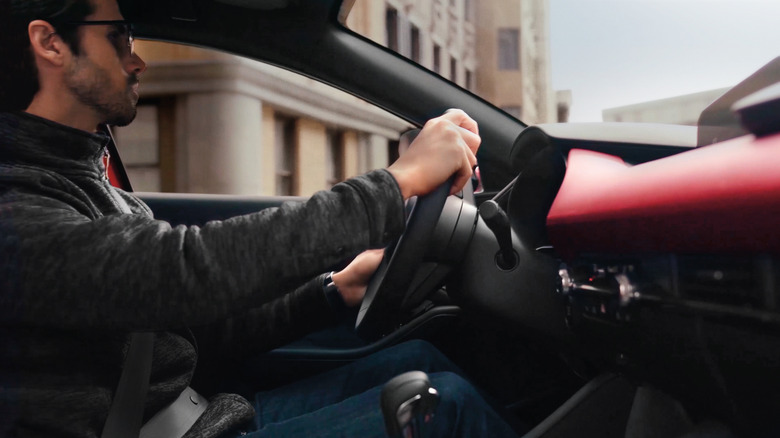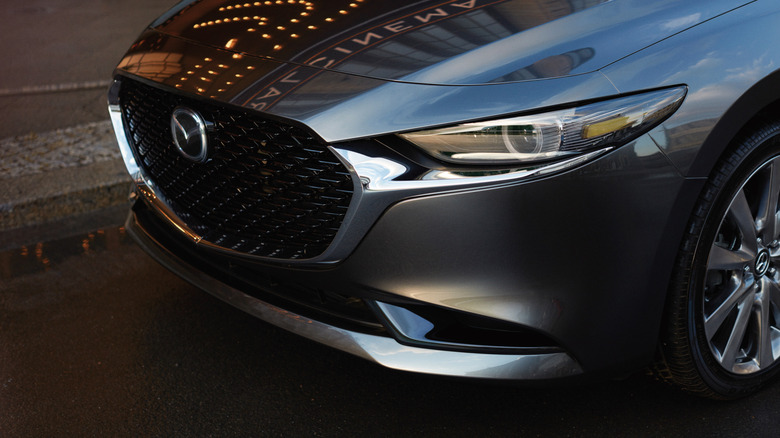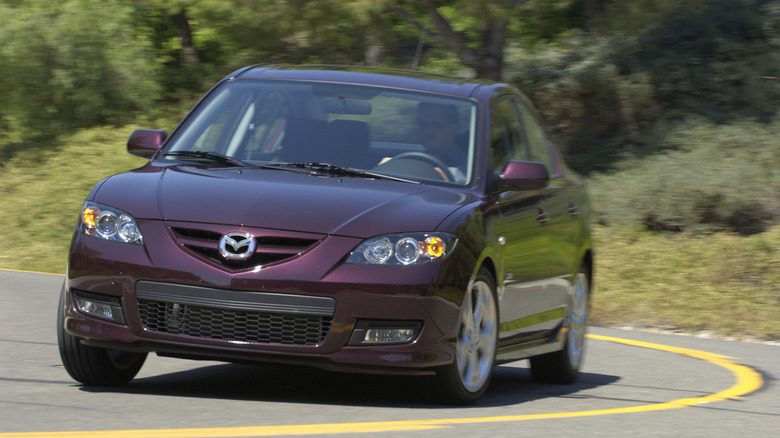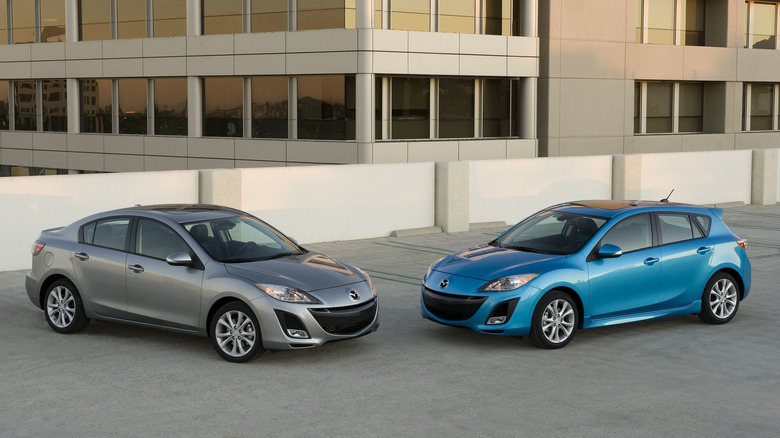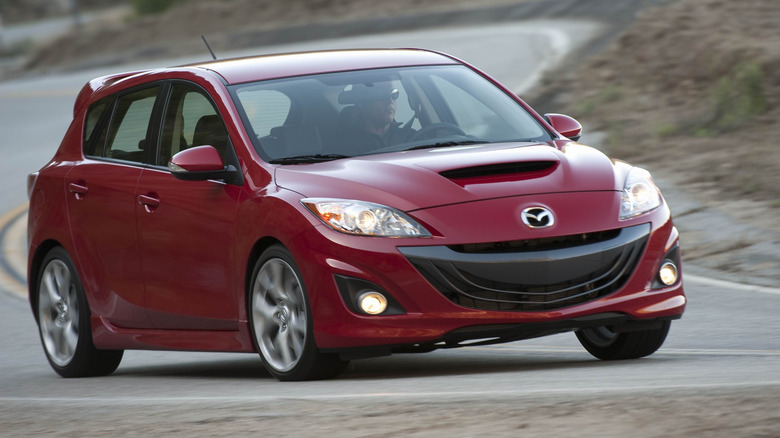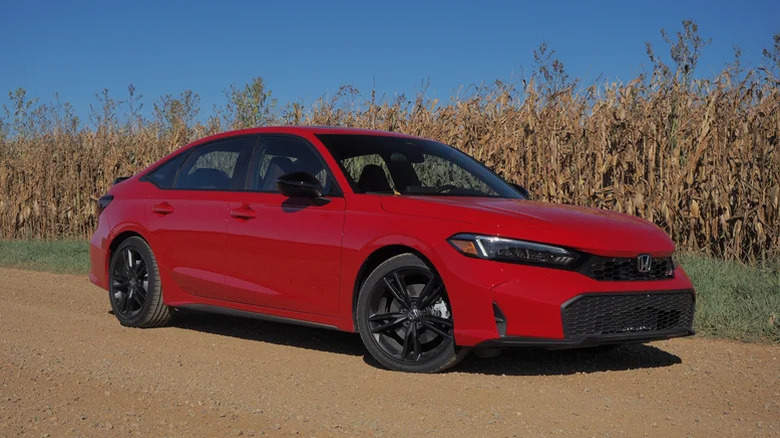10 Things You Should Know Before Buying A Mazda 3 (New Or Used)
Despite the continued popularity of SUVs and crossovers, buyers who want hatchbacks and sedans aren't short of choices for now. The Mazda3 is offered in both hatchback and sedan form, but both variants face tough competition. Helping the model stand out from the crowd is its styling, which remains sleek-looking despite being unchanged for a few years, as well as Mazda's focus on driving fun. The latter is something that's not easy to come by with today's tightening emissions regulations and the switch to electrification, so it alone is enough to make the Mazda3 a worthy competitor against its long-established rivals.
Despite its driving appeal, the Mazda3 does lag behind those rivals in some ways. Its efficiency and value retention score poorly compared to what else is on offer in the segment, and so buyers will potentially have to accept a few compromises as part of the deal. Whether or not those compromises are worthwhile will vary between individual buyers, but to help you make the right decision, we've rounded up a few things you should know before heading out to buy a new or used example.
The Mazda3 starts from around $25,000 for 2025
At the bottom end of its range, the Mazda3 is an affordable option. The sedan starts at $24,150 for 2025, while the hatchback starts at $25,150. Both figures exclude the brand's compulsory destination fee, which is $1,230 in Alaska and $1,185 everywhere else. The base trim for both variants is the 2.5 S, which packs a 2.5-liter SKYACTIV-G four-cylinder engine churning out 191 horsepower. Infotainment basics like Apple CarPlay and Android Auto are available as standard, but the car misses out on some of the niceties that higher trims include. Move up to the 2.5 S Select Sport trim and buyers get keyless entry, a leather-wrapped steering wheel, and dual-zone climate control as standard.
The cheapest trim to receive the Mazda3's more powerful turbocharged 2.5-liter engine is the 2.5 Carbon Turbo, which starts from $32,300 for the sedan and $33,450 for the hatchback, both excluding fees. That engine offers 250 horsepower as well as standard all-wheel drive, which the lowest trims miss out on. The range-topping trim for 2025 is the 2.5 Turbo Premium Plus, which starts at $36,000 for the sedan and $37,150 for the hatchback. With enough options ticked, the final price for a fully-loaded Mazda3 can even wind up north of $40,000.
Only a few changes have been made for the 2025 model year
Mazda has only subjected the Mazda3 to a handful of minor tweaks for 2025. One of the most notable is that the base 2.5 S trim is now available for both hatchback and sedan models, while it was only available on the sedan in 2024. All trims except the base trim also now feature Alexa integration as standard, which can be used to both control the car's climate and media functions hands-free and also control Alexa-linked smart home devices.
Also revised for 2025 is Mazda Online Navigation, which is available for the 2.5 S Premium and 2.5 Turbo Premium Plus trims. It gives Mazda's built-in navigation system an over-the-air update feature, which allows it to download updated maps and app upgrades, as well as improving suggested navigation routes. A six-speed manual transmission remains available for 2025, but only on the 2.5 S Premium trim. All other trims receive a six-speed automatic 'box with a manual shift mode.
We found the Mazda3's handling particularly impressive
Even without the optional manual transmission, we found the current generation Mazda3 to be surprisingly fun on the road, given its price. Its cabin was also a cut above the rest, feeling suitably upscale in top-spec form. Unlike some other automakers, Mazda hasn't hopped on the trend of removing all of its physical buttons and switches from the cabin either, which makes accessing most of its core functions feel intuitive.
We also found the car's cargo space to be more than adequate, although it's not the best in its class. The sedan variant of the Mazda3 only offers 13.2 cubic feet of cargo capacity behind the rear row, while the hatchback variant offers a more competitive 20.1 cubic feet. Even then, it lags behind class leaders like the Honda Civic hatchback, which boasts 24.5 cubic feet of space behind its second row.
The Mazda3 does not retain its value well
Value retention is not one of the Mazda3's strongest suits, and so buyers itching for a new example should be aware that they won't be able to claw back much of their money when it's time to upgrade. According to KBB, a new Mazda3 should retain only 36.6% of its original value after five years on the road. That's far short of the similarly affordable Toyota Corolla, which is forecast to retain 50.3% of its sticker price over the same time period, and the Honda Civic, which should retain 49.8% of its value.
In fact, the Mazda3's value retention rate is low enough to put it within touching distance of many notoriously fast-depreciating luxury car models. The latest data even shows the Mercedes S-Class (considered one of the benchmarks of the luxury car world) should perform slightly better than the Mazda in percentage terms, retaining 37.7% of its original value over the same time period. Of course, in dollar terms a Mazda3 owner will lose far, far less than the owner of an S-Class, but its resale rate being on par with a luxury barge in percentage terms still isn't exactly an encouraging sign for would-be new Mazda3 buyers.
On the other hand, it's great news for buyers looking for a used example.
There's no hybrid available, so fuel economy suffers
While its fuel economy is still reasonable for a non-hybrid car, the Mazda3's mpg figures don't come close to its electrified rivals. The most fuel-efficient two-wheel drive variant of the 2025 Mazda3 is rated for 31 mpg combined according to the EPA, while the best all-wheel drive variant achieves 30 mpg combined. For the most potent Mazda3 models, that combined figure drops to 26 mpg.
In comparison, the most fuel-efficient version of the Toyota Corolla Hybrid achieves a 47 mpg combined rating, and adding all-wheel drive only dents that efficiency slightly to 44 mpg. The Honda Civic boasts even higher numbers, with up to 49 combined mpg achievable according to EPA figures. Evidently, the Mazda3 pays for its lack of electrification, even if it offsets that by being more enjoyable to drive than either of its fuel-sipping rivals. Still, the prospect of higher fuel bills over the long run might be enough to turn off some drivers.
The Mazda3 is not made in the U.S.
The Mazda3 is a model with global appeal, and it's built all over the world too. Various factories build different variants of the car, including Mazda's Hofu Plant in Japan, and the brand's MMVO plant in Mexico. None of the factories that produce the Mazda3 are located in the U.S., which potentially makes them vulnerable to the effects of any tariffs imposed by the current U.S. government. As of this writing, the impact of any tariffs remains unclear, although Mazda has already acknowledged that they might result in price rises in the future.
It's worth reiterating that Mazda has not yet confirmed price rises for any of its models as of the time of writing, including the Mazda3. It has been confirmed that any existing inventory, meaning any new cars that have already reached dealerships, will not change in price, even if the prices for cars that have yet to be shipped to America might go up. Buyers looking for a used car remain unaffected by the new changes.
The Mazda3 has been around for over two decades
Used Mazda3 buyers will have plenty of inventory to pick from, as the Mazda3 has been on sale for over two decades. It debuted in 2003, replacing the Protegé, with Mazda touting the car as being stiffer and roomer than its predecessor. Since its inception, it has aimed to bring a sporty element to its budget bones, although the original generation's 148 horsepower base-engine won't feel all that sporty to most drivers today.
The second generation of the car was unveiled in late 2008 at the Los Angeles Auto Show. It was essentially an updated version of the original, with the same platform but new styling and revised powertrains. It didn't stick around long, as the third generation hit the roads in 2013. The fourth, current generation car was introduced for the 2019 model year, with its interior and exterior styling remaining mostly unchanged to the present day.
The 2010 model year is worth avoiding
There are always going to be some model years of a long-running car that attract more complaints than others, but in the case of the Mazda3, there's only one model year that's really worth steering clear of. That model year is the 2010 Mazda, which has received 680 complaints to the NHTSA as of this writing. The next-worst offender, the 2008 Mazda3, received less than half of that figure.
Many of the owner complaints regarding the 2010 model concern its ABS, which is alleged to be prone to failure. Other concerns include a melting dashboard, which is reported to cause visibility issues, and issues with the seats moving by themselves. Mazda acknowledged the seating issue back in 2017 and announced a recall, but reports have continued to show seat-related issues in the following years. As of this writing, neither the dashboard issue nor the ABS has been instigated for recall or investigation.
Mazda once offered a Mazda3 hot hatch
Today's top-spec Mazda3 packs 250 horsepower, but back in 2007, Mazda unveiled an even more powerful version of the car. The 263 horsepower Mazdaspeed3 was a true hot hatch, with the brand claiming it had a top speed of 155 mph and a 0-60 mph time of less than six seconds. For context, the Volkswagen Golf GTI of the same year only offered 200 horsepower. Mazda made the car rare from the start, capping its imports to a maximum of 5,000 examples annually.
It proved to be a success, and a second generation of the Mazdaspeed3 was launched before Mazda eventually discontinued the model in 2014. Today, used examples remain well within affordable territory, with its average sale price over the last five years hovering around $11,000 according to Classic.com data. A number of higher mileage examples have sold for under $8,000 or less, with the cheapest recorded auction sale hitting only $4,500.
It's worth considering the Mazda3's competition
While the Mazda3 is an appealing option in both new and used form, it has plenty of competitors. It's tricky to beat either the Toyota Corolla Hybrid or the Toyota Prius for fuel efficiency and affordability. Neither of the Toyotas is fun to drive, and neither is the similarly affordable and efficient Civic Hybrid hatchback, at least in base spec form. However, the newly refreshed Civic Si is a different matter — it's both very enjoyable on the road and also keenly priced, being available from just over $30,000 once destination fees are accounted for. That's several thousand dollars less than a top-spec Mazda3, although the Civic Si isn't quite as powerful, with 200 horsepower on offer.
Anyone who prefers their affordable sedans with a European badge might want to head to a Volkswagen dealership and check out the Jetta GLI, which promises similarly keenly-priced thrills and more trunk space than the Mazda3 sedan. Finally, the Hyundai Elantra N is somewhat of a dark horse in the sporty sedan segment, being a relatively new addition to the segment but offering a punchy 276 horsepower engine for around the same price as a top-spec Mazda3.
Whether you're looking for a base-spec runaround or are willing to splash out a little extra for a sportier hatchback or sedan, there are plenty of other options. Yet despite its flaws, the Mazda's driving dynamics and stylish cabin keep it a strong contender in its class.
